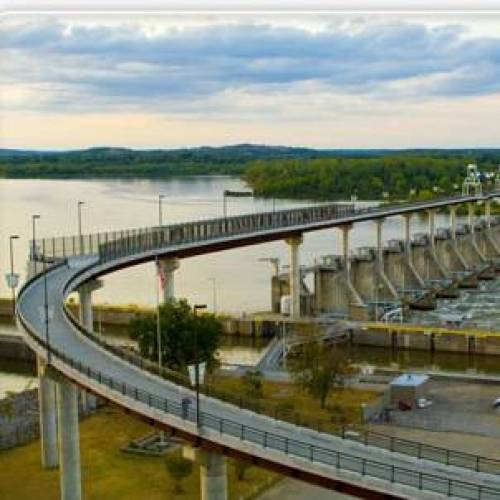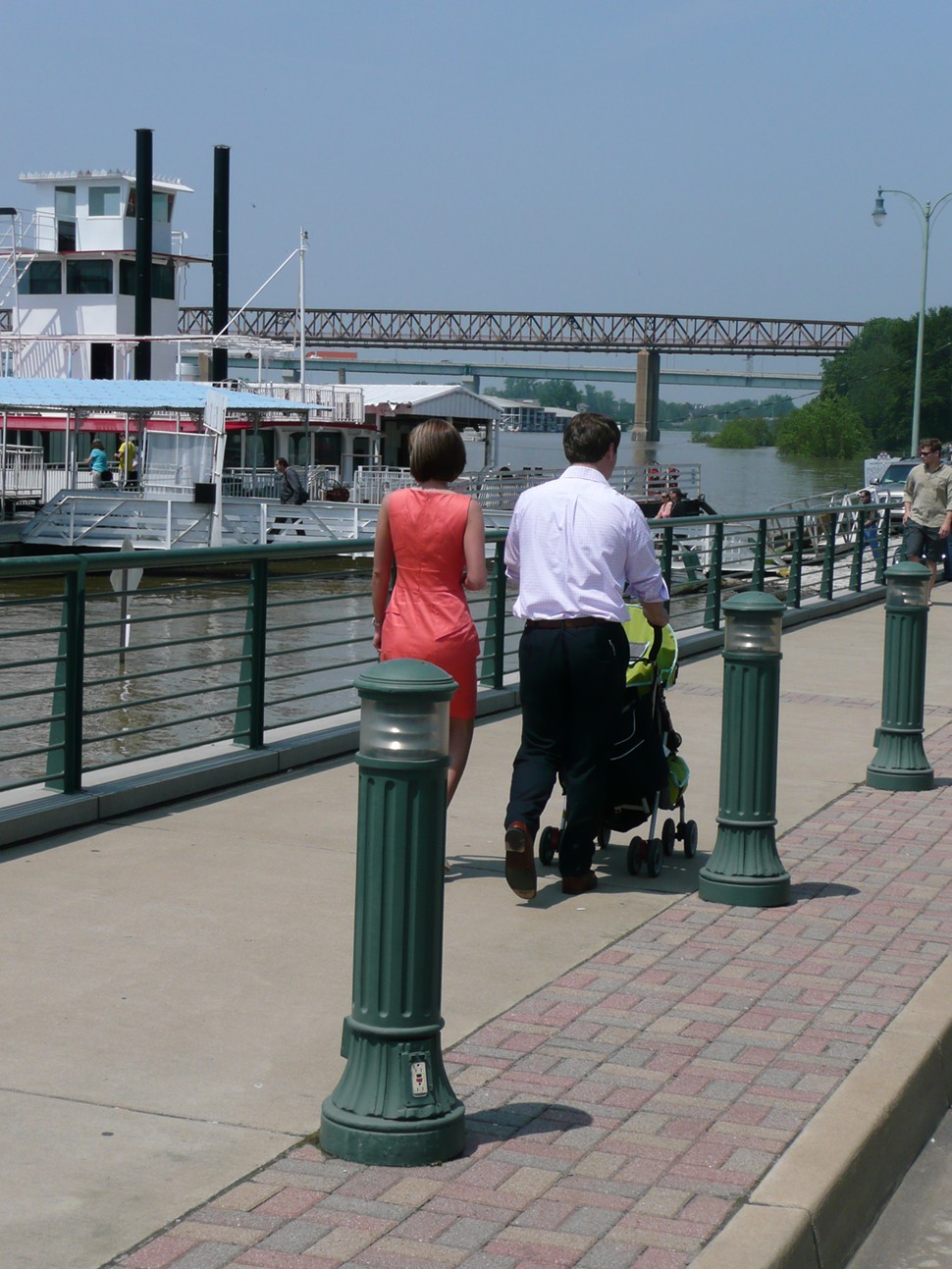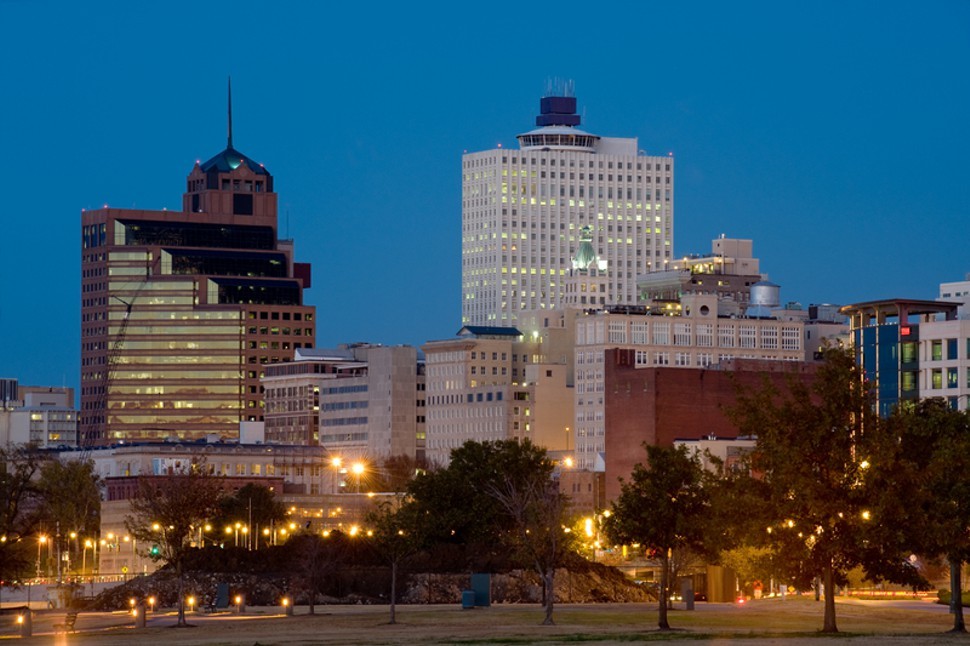Ward Archer and friends have reposted this excellent video of their group bike ride from Little Rock to Memphis last summer. It shows the current scary sidewalk over the Mississippi River and a computer-generated rendering of the future Harahan Project, scheduled for completion in 2014. The rendering is not state of the art as far as the fencing and other details but you get the idea. Nice photography, music and narration. Check it out while the Harahan Project and Main Street to Main Street Connector are in the news. The ride was 186 miles. For those interested in something shorter, Little Rock has a great network of trails on both sides of the Arkansas River and over the Big Dam Bridge.
Tag: Harahan Project
Jeff Speck, author of Walkable City: How Downtown Can Save America One Step at a Time, suggests six quick fixes for the riverfront.
At the request of Mayor A C Wharton, Speck reviewed some 20 riverfront plans dating back more than 30 years. He gave a nice straightforward 90-minute talk to about 125 people at the Memphis Cook Convention Center Monday. Speck showed familiarity with the past, present, and future of the riverfront. He was last here for an extended visit in 2008, but also remembers the 2002 grand vision that included a land bridge and high-rise buildings on Front Street. He called it “as imaginary as it was imaginative.”
“The last thing the city needs is another plan,” he said.
Here are his six suggestions, along with my comments.
The Pyramid: Its connection should be to Main Street, not Front Street. The Pinch should focus on attracting people from conventions, not travelers on the interstate. Bass Pro “still has a long way to go” to understand the city. Speck suggests selling off four acres on Bass Pro Boulevard (the southern entryway next to the state visitors center) for private development and turning the boulevard into two or three lanes of car traffic and a lane for bikes and pedestrians.
Comment: I watched the Tunica casinos come out of the ground in 1994-1995. There was an incredible sense of drive, mission, and urgency. The Bass Pro Pyramid does not have that. I doubt it will meet the 2013 opening deadline. The boulevard is small change.
Mud Island Park: Still disconnected from the rest of downtown. Needs stairs to the monorail from the visitor center. Speck suggests a water taxi from Beale Street to the tip of the island. He thinks the park should be open year round. Speck did not comment on the naming controversy over Jefferson Davis Park, which is just south of the visitor center. He said this park is “the next great waterfront opportunity.”
Comment: Visitor experts overestimate Mud Island River Park every time. Memphians are bored by it, and it attracts very few tourists. It is closed six months for a reason.
Riverside Drive: Shrink it from four lanes to three lanes or two lanes. Include a buffered bike lane and a lane for parallel parking. Take the parking lots out of Tom Lee Park and next to Beale Street Landing. Keep Memphis in May in the park. Break the park up into small areas separated by trees.
Comment: A $42 million boat dock with a restaurant with no parking lot. Yikes.
The Cobblestones. Speck said it is about impossible to make it usable and historically accurate at the same time, given the demands of accessibility and preservationists. He said the RDC should finish the project and add light structures “draping” on it.
Comment: The man has done his homework.
The Riverwalk: By this he meant the sidewalk and Bluff Walk going from the Pyramid to Martyr’s Park. It now leaves the riverfront and goes behind the law school and into South Bluffs residential development. Speck suggests making it more linear and always within sight of the river. The walk should be extended between the Church of the River and Channel 3’s offices to the French Fort area south of the Harahan Bridge.
Comment: The section along the railroad tracks between Union and Madison is a pain, but I like the dogleg through South Bluffs. Those who want to stay in sight of the river can take the 84 steps down from the Bluff Walk to Tom Lee Park at Huling Street and follow it south to where it ends near the church.
Beale Street to Beale Street Landing: Needs “edging” — development along Beale Street by the parking lots near the river, once envisioned as the site of One Beale, a tall hotel and condo. The Harahan Project needs something on the West Memphis side in the floodplain, maybe just a loop trail and a pavilion, because Main Street West Memphis (the other half of the “Main Street to Main Street” idea) is too far away.
Comment: The fact that there is basically nothing on the bluff at the corner of Beale and Riverside Drive, a pretty famous American intersection, is sad. This corner, like the Pinch on the north end of downtown, actually had more activity 30 years ago when Captain Bilbo’s was around.
To learn more about Speck and his 74 pages of observations and proposals, visit the city of Memphis website.
Nice river trail they have in Little Rock, and November is the month to see it. The 15-mile loop follows both sides of the Arkansas River through downtown Little Rock and North Little Rock from the Clinton Museum to the spectacular Big Dam Bridge, the world’s longest pedestrian/bicycle bridge. If Memphis can create something like this with the Harahan Project, we will have a winner.
I had seen that Arkansas The Natural State television commercial and the Arkansas tourism ads in our publications lots of times but had never been in Little Rock in the fall when the colors are at their peak. The Big Dam Bridge, completed in 2006, sounded like a bike magnet. Little Rock is close (two hours in the truck convoy on Interstate 40) and cheap (about $200 for the weekend including bike rental, meals, gas, and a room at the Wyndham Riverfront in North Little Rock).
I started in North Little Rock at River Trail Bike Rentals, where owner David Fike rented me a hybrid for $16 for half a day. The shop is next to a park inside the floodwall near the landing for the Arkansas Queen and the U.S.S. Razorback World War II submarine. There’s a big parking lot, historic murals on the floodwall, a public restroom (open and clean) and a water fountain (cold and working). The riverbank is crushed rock with a concrete pathway to the boats. I bet it didn’t cost $42 million.
On the north side, the trail passes Verizon Arena, the minor-league baseball park, Big Rock Quarry, high bluffs, the Burns Park golf course, Centennial Park soccer fields, and a wetlands. On the south side (downtown Little Rock) it passes The Peabody, River Market, a sketchy section of downtown where the trail is incomplete, Rebsamen Golf Course, and a suburban office center that includes the headquarters of Dillard’s and Verizon.
On Saturday, the north entrance to the Big Dam Bridge was closed for some minor repairs. Some walkers and a few bicyclists were scaling the fence, but I decided to ride back downtown, cross over on the Presidential Bridge, and repeat the trip on the south side. The damn bridge was open on that side, and the view to the west toward volcano-like Pinnacle Mountain was worth it. You get a sense of Little Rock and the Arkansas River as a Gateway to the West, like St. Louis. The Chickasaw Indians were force-marched and transported on barges from Tennessee to Oklahoma in the 1840s. The map says Pinnacle Mountain is eight miles away, but the river trail only goes part way, so I decided to drive to it on Sunday. The climb to the top and back is pegged at two hours on the sign in the parking lot. Sure . . . I can do this in an hour, maybe a little more. Two hours later I was back at my car, sore-kneed from scrambling up and down rocks and soaked in sweat.
Like the Cumberland in Nashville and the Tennessee in Chattanooga, the Arkansas is a manageable river that lends itself to recreation and riverside development. Little Rock and North Little Rock have clustered their hotels, corporate buildings, sports facilities, and tourist attractions. The Clinton Museum was a big boost, as was the Big Dam Bridge. But the cities do the little things right, too. The 15-mile River Trail loop is one of them.
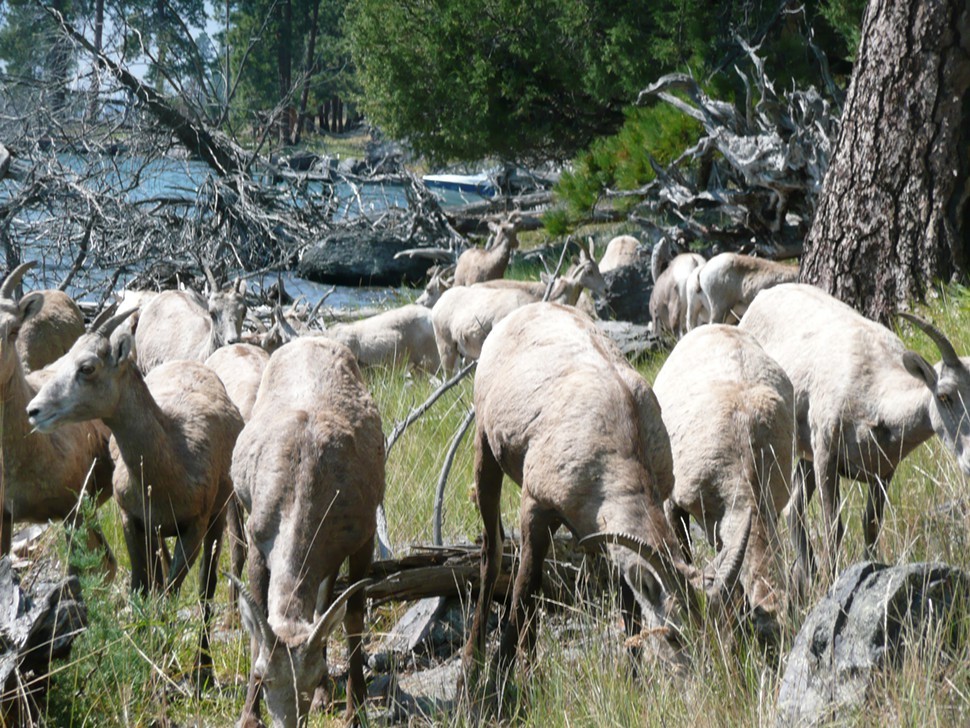
- John Branston
- Residents of Wild Horse Island
“Going off the grid” is an expression I first heard from a young friend a few years ago and have since seen and heard hundreds of times. But until last week I had not gone off the grid for more than a couple of days.
It helps to be in western Montana, a place where, it is said, 20-somethings go to retire and, it should be added, parents go to mooch off them.
Thank you, smartphones and iPads. If you don’t have one, going off the grid has never been easier. My hosts had no televisions, no wireless, no land lines, and no newspapers. But they did have pickup trucks, a small boat, and a lot of know-how about the Hiawatha Trail, Wild Horse Island, Flathead Lake, and the mountain ranges around Missoula. More than fair trade.
I got through an Anne Tyler novel in three sittings, spent less than three minutes thinking about the unified school district, drank four huckleberry milk shakes, and ate three pounds of black cherries. Puttered around Flathead Lake, the biggest freshwater lake in the West, on a fishing boat. Saw a forest fire close up and watched planes skim the lake to scoop water to dump on the fires.
And ate lunch near a curious herd of big horn sheep on mostly uninhabited Wild Horse Island in Flathead Lake. My son, an avid hunter, is going to hike several miles in rugged back country next month, risking life and limb for a chance to get a shot at a ram. On Wild Horse Island we hiked within 100 yards of three of them.

- John Branston
- Hiawatha Trail tunnel
The Hiawatha trailclaims to be the most scenic rails-to-trails bike route in America and the 15-mile trail starts with a 1.7 mile tunnel, made more exciting by an inadequate headlight and an unfamiliar rental bike and water dripping off the walls in the pitch blackness. I was lucky to catch up to a straggler in another group with a better light.
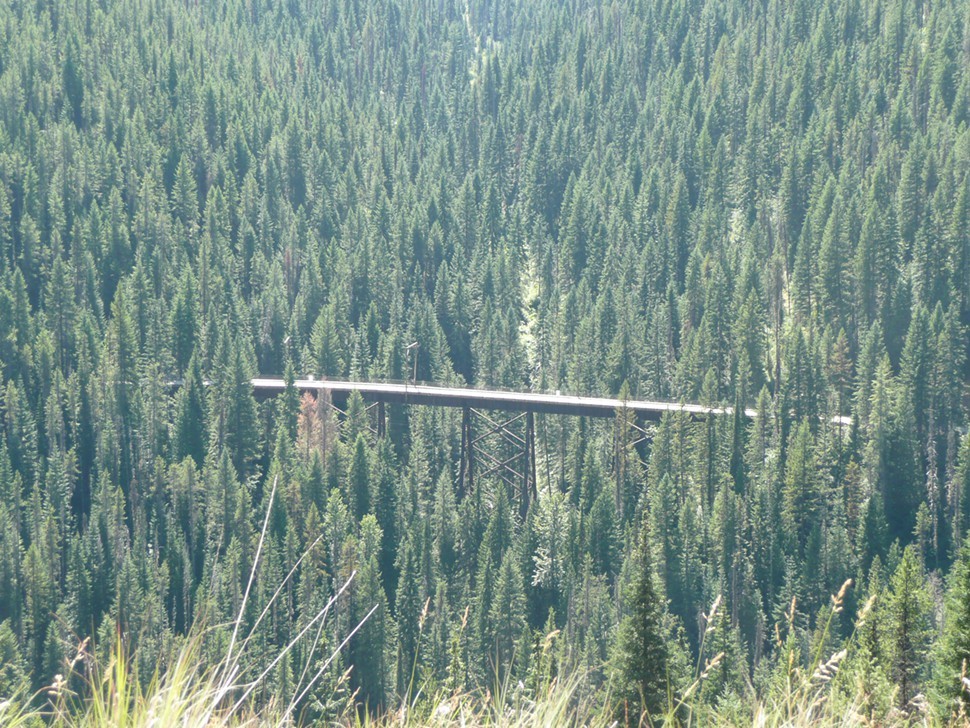
- John Branston
- Hiawatha Trail trestle
The trestles over the creeks were built by the Milwaukee Road railroad, employing the same high-grade engineering of the Harahan Bridge across the Mississippi. Definitely a “wow” factor in high bridges.
The Great Rivers and Underground Railroad trails go through Mississippi and Middle Tennessee; The Southern Tier goes through Mississippi and Alabama; and the TransAmerica Trail goes through Kentucky. But Memphis is not on the North American biking map of transcontinental trails, at least as far as Adventure Cycling is concerned, or at least not yet. The Harahan Project could change that.
As Matthew Frank wrote in Montana Headwall magazine, “cyclists hate the interstate as much as headwinds and hemorrhoids” but in some rural state like Montana and North Dakota that’s all there is. For the first time in its history, Adventure Cycling rerouted major sections of the Northern Tier and Lewis & Clark routes from state highways to Interstate 94 because of the oil boom that has drawn a steady stream of trucks to western North Dakota and eastern Montana.
Interstate cycling, legal but discouraged in several states, can be dangerous. A cyclist in West Memphis was killed in an accident earlier this month on Interstate 55 three miles from the river. In Missoula, I ran into a grizzled cyclist making his way from North Dakota to Santa Cruz, California on a bike that looked like it had been salvaged from a junkyard and loaded with bags carefully balanced from the handlebars.
He had stopped in Missoula to have his picture taken at Adventure Cycling, adding to the hundreds of snapshots posted on the wall. But his was not a particularly happy tale. He had been deliberately forced off the shoulder by cars and trucks, shouted at, and worn down by the heat so much that he hitched a ride, bike and all, on a flatbed truck and hopped a freight car on another leg.
“I couldn’t stand the heat so I got off 40 miles outside of town,” he said.
He had 1,206 miles to go.
Pigging Out on Riverfront Projects
The city’s pursuit of riverfront projects, spearheaded by Mayor A C Wharton and go-to guy Robert Lipscomb, looks manic, unsynchronized, and a bit desperate.
The latest play pretty in hot pursuit is the Empress of the North, a white-elephant steamboat replica envisioned as a floating hotel. As reported by Amos Maki of The Commercial Appeal, Wharton said “we have submitted a proposal.”
Whoopee. I was reminded of the parental admonition to “clear your plate” before going back to the buffet for more when I was a lad.
Here’s the tally of what’s on our plate already.
Bass Pro Shops. The latest rendering shows a major makeover of the exterior of the Pyramid, with a band of glass to admit natural light. The fate of the observation deck is unknown. The connection to The Pinch, and what will be developed in the Pinch, is unclear. The interstate connection to Front Street is on the drawing board. The interior construction, including the indoor swamp and hotel, is in the very early stages. The project was first proposed seven years ago. Bass Pro has other megastores in the works in Little Rock and New Orleans. I would bet a bass lure the Pyramid opening is delayed.
Beale Street Landing. Low water forced the American Queen to dock at Greenbelt Park this summer. The dock itself was moved to the cobblestones to allow dredging at the landing. The blockish structure at the top of the hill, trust me, is going to open some eyes. The “floating islands” have yet to be constructed. The usefulness of a boat dock for an occasional steamboat visit is questionable. The relative scarcity of parking concerns the current Memphis boat company. The marriage with Memphis in May will be interesting. The price is $42 million, and the concept is nearly 10 years old, and the opening is supposed to be later this year. The cobblestones work has been pushed back so many times I have lost count.
Pinch District. The connection between Bass Pro and St. Jude Children’s Hospital, and the prospective retail anchor for the north end of downtown and the convention center. Forget the colorful handouts and renderings, The Pinch is a small collection of restaurants, condos, blight, and vacant buildings. The convention center and hotel are not part of Phase One of Bass Pro. Nor is funding for it included in the $200 million budget.
Mud Island River Park. Closed half the year. Nice summer concert venue, though.
Tom Lee Park. Too hot in summer. Given to Memphis in May in April and May. Torn up for a few weeks after that. No major structures or big trees because that would cramp Memphis in May activities. Called “the worst riverfront park in the country” by Benny Lendermon of the Riverfront Development Corporation.
Harahan Project. Bike and pedestrian path over the river is slated for 2014 and funding has been secured. Now it needs focus.
Floating hotel. Kitschy. There’s one in Chattanooga. Nice place to have a drink on the Tennessee River. But the boat is old, the ceilings low, and the space cramped. The fact that the Empress of the North has been docked for several years and is in custody of the United States Maritime Administration speaks volumes about its viability. And the subsidies that would be required to sustain it.
Add to this, Lipscomb is also point man for the fairgrounds, Overton Square, Triangle Noir, replacement of public housing, and he has two city jobs.
Focus. Finish. Clear your plate.
Ten years ago, not many people would have foreseen Memphis in the grip of NBA Playoffs fever. Nor would they have guessed that the city and county school systems would be forcibly merged. Or that suburban homebuilders would scale back or go broke. Or that suburbs would be seriously talking about starting their own school systems (well, maybe that one was predictable).
So how does the unthinkable become thinkable? I’ve been thinking about that in light of a new book by a 93-year-old Memphian, a 36-year-old issue of our company’s monthly magazine, and the upcoming debate over the City of Memphis budget and various proposals to avoid a property tax increase. Sometimes the unthinkable is doable, sometimes it isn’t, and sometimes it just take a lot of patience. Here are three examples.
NO WAY: STATE INCOME TAX
Tennessee is one of a handful of states that does not tax earned income. Every once in a while, a maverick comes along and points out the inequity of the state tax structure that relies on the highest sales tax (even on groceries) in the country. I have been reading “Lewie,” an autobiography by the esteemed lawyer and Republican blueblood Lewis Donelson.
In the early 1960s, Donelson was named to a “Committee of 100” to plan the future of Tennessee.
“I had gotten interested in Tennessee’s financial structures, especially the pernicious aspects of the state’s heavy general sales tax,” he wrote. “This resulted in lower-income citizens being taxed a much higher percentage of income than upper-income individuals.” Then as now, the state tax structure did not grow as rapidly as inflation, and there were frequent increases in the sales tax. Donelson argued for a state income tax.
“I made a motion and the committee adopted a resolution recommending an income tax. The only result of this resolution: the death of the Committee of 100.”
Donelson was anything but a screaming radical, but he was an excellent lawyer and a good enough politician to serve a term on the Memphis City Council and stints as an aide to two Tennessee governors, neither of whom was crazy enough to propose a state income tax while in office. That kamikaze mission was undertaken by another Republican governor, Don Sundquist. His eternal reward was to be shunned by his party and shouted at by crowds of angry protesters at the Capitol for supporting an income tax that, once again, went nowhere.
MAYBE A WAY: TAX ALTERNATIVES
Some members of the Memphis City Council suggested bringing the income tax up again if for no other reason than to stir things up in Nashville. Other members suggested a payroll tax to get revenue from people who work in Memphis or its suburbs but live outside of Shelby County. That idea isn’t going anywhere either as long as the city’s biggest employer — FedEx — opposes it. FedEx CEO Fred Smith has said publicly many times, “if you want less of something, tax it.” End of story.
A more promising longshot was proposed by Council member Janis Fullilove. She said nonprofits and companies that have received PILOTs or payment-in-lieu-of-taxes tax breaks should pay more because they own so much property. It’s not like nobody else at City Hall knows the score. On the contrary, everyone knows the score. At a retreat for the council and administration earlier this year, Housing and Community Development Director Robert Lipscomb handed out charts showing how little taxable property there is in Memphis relative to the full size of the city.
To take one example, the nonprofit hospital giants have big salaries and lots of free cash. Here’s a column from a couple of years ago. Blogger Tom Jones has been a bulldog on the issue of PILOTs for several years. Here is one particularly informative post on how PILOTs became contagious in Memphis and Shelby County. But voices in the wind are easily ignored or dismissed. The same goes for another study of PILOTs or a blue-ribbon committee, a typical Mayor A C Wharton “solution.” What is needed is more spark and some fire.
At least three things would have to happen for Fullilove’s proposal to get anywhere. One, Wharton would have to embrace it, as the mayor of Boston did last year. Two, some key nonprofits would have to break ranks and agree to voluntarily increase their payments to local government, putting pressure on others to follow suit. And, three, The Commercial Appeal would have to use some of its reporting clout to investigate nonprofits (as the Boston Globe did), and influential organizations such as Memphis Tomorrow and the Chamber of Commerce would have to lend support.
YES WAY: BIKE LANES AND THE HARAHAN BRIDGE
In 1976, “city of memphis” magazine, the forerunner of Memphis magazine, ran an article by Max Heine entitled “Bicycling Memphis.” It is uncanny how it foreshadows developments 35 years later.
The author argued that there were 283,000 (!!!) “admitted pedallers” in Shelby County and that bike lanes should be installed on streets “separated from traffic by a stripe or curb, with signs designating the route.” A planner with the Memphis and Shelby County Planning Commission mapped out 25 routes, including one from Overton Park and Overton Square to downtown and and another connecting the fairgrounds and the the city’s three colleges. The cost of the three main routes was estimated at $25,000-$30,000. The chairman of the City Council “was not familiar with the proposed routes but pointed out that the city had replaced many of the curbside sewer covers” that could obstruct riders.
Then there was this bit of blue-sky thinking:
“One exciting proposal calls for a pedestrian/bike crossing on one of the abandoned car lanes of the Harahan railroad bridge . . . About $6 million in federal funds is available through the Urban Bikeway Demonstration Act.”
The article said “bikommuting” was an emerging issue, and noted that the second annual Bicycle Commuter Day was scheduled for May 28, 1976.
Fast forward to 2012. The Harahan Project is alive and well, and May 18th is officially Bike to Work day.
How Memphis Should Play the Rankings Game
As even their creators and honorees will admit, most of the lists that purport to rank cities are horse crap. But once in a while, one of them comes along that, like a seven-car crash, demands your attention.
Case in point: Outside magazine has named Chattanooga “the best Outside town in America” and one of the “Best Towns Ever.” Chattanooga! The decaying railroad town in the shadow of Lookout Mountain and Rock City. I have been there dozens of times over more than 50 years and was moved to congratulate Candace Davis of the Chattanooga Convention and Visitors Bureau.
“Thank you John,” she replied in an email. “I typically don’t send out mag ranks either, but we do have a list of them compiled. With this being such a great publication with national and international recognition, we thought it was definitely appropriate. I mean how often do you get to be the Best EVER??”
If you are not familiar with it, Outside features extreme sports and doesn’t give a damn about football, baseball, or golf. I like to look at the nice pictures and read the articles which remind me of so many things I either cannot or would not do, like rock climbing, hang gliding, or paddling a surfboard from a standing position like I saw people doing this year in Florida and California and Shelby Farms.
The press release says “Outside scoured the nation to find dream cities that offered a balance of great culture, perfect scenery, stress-free and reasonable cost of living, and, of course, easy access to the outdoors.” Finalists included Charleston, SC; Madison, WI; Portland, OR; Portland, ME; Santa Fe, NM; Ashland, OR; Boulder, CO; Burlington, VT; Tucson, AZ. A Facebook poll put our Tennessee neighbor over the top.
While I’m sure researchers put in long hours weighing “stress-free and reasonable cost of living” factors, the emphasis was on the visuals, just as Miss Universe must have, oh, never mind. Chattanooga, if you expand its radius 75 miles, has the goods from whitewater to mountain bluffs to the downtown river walk.
Memphis can play this game. Many of us have seen the warts in Chattanooga and the other finalists, and they are glossed over in such contests. If Shelby Farms, the riverfront, the Harahan Project, the Kroc Center, and Bass Pro work out as hoped, Memphis could and should be on someone’s list of best outdoor places.
As I wrote in this blog last week, I would pair that brag with a not-too-subtle reminder that Memphis is pretty much disaster free at a time when the rest of the country is reeling from floods, droughts, hurricanes, blizzards, forest fires, and monumental traffic jams. In today’s Wall Street Journal there is a story about a bridge closing on Interstate 64 in Louisville (one of our peer cities) that has “doubled commuting times for thousands” and backed up traffic for six miles in Indiana. UPS, Humana, and the University of Louisville are in scramble mode. Sorry, guys, FedEx is running like clockwork.
In the same newspaper, I read that Texas set a record as the temperature hit 100 degrees for the 70th day this year. The state is parched. Tennessee, and Memphis, are mostly green, and we are the Saudi princes of water.
If I were selling Memphis I would point that out. If it’s good enough for FedEx, maybe it’s good enough for you, etc. etc. If you like to bike, skate, run, fish, or paddle, come check us out.
Nobody said contests were fair and balanced.
